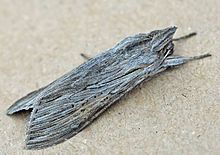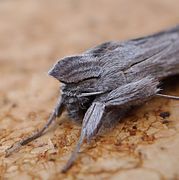| Shark | |
|---|---|

| |
| Scientific classification | |
| Domain: | Eukaryota |
| Kingdom: | Animalia |
| Phylum: | Arthropoda |
| Class: | Insecta |
| Order: | Lepidoptera |
| Superfamily: | Noctuoidea |
| Family: | Noctuidae |
| Genus: | Cucullia |
| Species: | C. umbratica |
| Binomial name | |
| Cucullia umbratica (Linnaeus, 1758) | |
| Synonyms | |
| |
The shark (Cucullia umbratica) is a moth of the family Noctuidae. The species was first described by Carl Linnaeus in his landmark 1758 10th edition of Systema Naturae.
Distribution
This species is widespread throughout much of the Palearctic realm (Europe, Russia, Afghanistan, Turkestan, and Mongolia), but has recently also been reported from North America, from the Magdalen Islands in Canada.
Habitat
These moths inhabit a range of open environments such as heaths, meadows, forest edges, gardens, parks and suburban areas.
Technical description
For a key to the terms used, see Glossary of entomology terms.Cucullia umbratica is a fairly large species, with a wingspan of 52–59 millimetres (2.0–2.3 in). These moths have long, narrow wings giving a streamlined appearance. The forewings are dull brownish grey, the cell and space beyond are paler, with dull greyish buff. A fine black line runs from the base below cell. The usual lines and stigmata are ill defined. Orbicular is represented by two or three dark points, reniform by a curved black line at lower end. Slight black dashes are present before termen, above vein 3 and below vein 2, and a longer black streak appears above middle of vein 4. The hindwings of male are white, with the veins and termen narrowly fuscous, while in the female thy are wholly brown, with paler base. The larva is grey or brown with black spots.
This species is quite similar to the chamomile shark (Cucullia chamomillae), but it shows two bands, one pale and one grey, on the fringe of the hindwing, whereas in the last there are three bands.
Biology
Adults fly in the dusk and in the evening from mid-May to mid-August and feed on nectar of a variety of flowers. They are attracted to light. Larvae feed mainly on sow thistles and lettuces and others. The main recorded food plants are lady's bedstraw (Galium), hawkweed (Hieracium), catsear (Hypochaeris), lettuce (Lactuca), hawkbit (Leontodon), campion (Silene), sow thistle (Sonchus) and dandelion (Taraxacum). There is one generation per year (univoltine species). This species overwinters as a pupa.
- The flight season refers to the British Isles. This may vary in other parts of the range.
Gallery
-
Caterpillar
-
Imago
-
 Head detail
Head detail
-
Mounted specimen - male (top) and female
References
- Fauna Europaea
- ^ Savela, Markku, ed. (August 19, 2020). "Cucullia umbratica (Linnaeus, 1758)". Lepidoptera and Some Other Life Forms. Retrieved February 9, 2021.
- "931515.00 – 10194.1 – Cucullia umbratica (Linnaeus, 1758)". North American Moth Photographers Group. Mississippi State University. Retrieved February 9, 2021.
- ^ Kimber, Ian. "73.052 BF2216 The Shark Cucullia umbratica (Linnaeus, 1758)". UKMoths. Retrieved 9 February 2021.
- Seitz, A. Ed., 1914 Die Großschmetterlinge der Erde, Verlag Alfred Kernen, Stuttgart Band 3: Abt. 1, Die Großschmetterlinge des palaearktischen Faunengebietes, Die palaearktischen eulenartigen Nachtfalter, 1914
- Robinson, Gaden S.; Ackery, Phillip R.; Kitching, Ian J.; Beccaloni, George W. & Hernández, Luis M. (2010). "Lepidoptera Genus: starts with cucullia Lepidoptera Species: starts with umbratica". HOSTS - A Database of the World's Lepidopteran Hostplants. Natural History Museum, London.
- Chinery, Michael (1991). Collins Guide to the Insects of Britain and Western Europe.
- Skinner, Bernard (1984). The Colour Identification Guide to Moths of the British Isles.
External links
- Paolo Mazzei, Daniel Morel, Raniero Panfili Moths and Butterflies of Europe and North Africa
- Lepiforum e. V.
- Svenska Fjarilar
| Taxon identifiers | |
|---|---|
| Cucullia umbratica |
|
This Cuculliinae article is a stub. You can help Misplaced Pages by expanding it. |